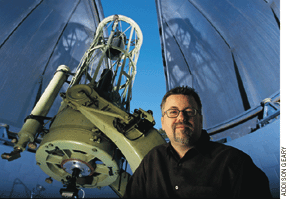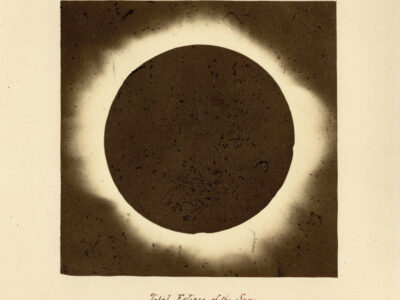
David Koerner, a Penn astronomer and accomplished pianist, probes the universe for clues about how prevalent planetary systems, and life itself, may be.
By Susan Lonkevich | Illustration by Anastasia Vasilakis
Dr. David Koerner was getting groggy. It was 2 a.m. in the control room on top of Hawaii’s dormant volcano Mauna Kea, where he and a team of astronomers were operating a special infrared camera with one of the world’s largest telescopes, the Keck II. The late hour and oxygen-thin air—at 14,000 feet above sea level—were making him tired, so the scientist had settled back to rest while a colleague from NASA’s Jet Propulsion Laboratory began searching for the next star on their list, unimaginatively named HR 4796.
But the 10-million-year-old object seemed to have disappeared when viewed at mid-infrared wavelengths. With his colleague growing exasperated, Koerner perked up and wondered if the object were more elongated than they thought; he made a few adjustments to the instrument. Suddenly, from 220 light years away, in the constellation Centaurus, an unexpected image appeared on the computer screen.
“We’d been staring at it the whole time,” says Koerner, now an assistant professor of physics and astronomy at Penn. “We thought we couldn’t even see the star. Next thing, we found a star with a disk” around it. “We went ballistic.”
He ran into the kitchen to rouse the others from their break. Almost immediately, they noticed that the dust- and gas-filled disk was brighter on the ends than in the center. That seemed strange. “We were saying, ‘Wow, does that thing have a big hole in it?’” It did, in fact—an empty region 100 astronomical units (A.U.) in diameter, just larger than our own solar system. (One A.U. equals the distance from the Earth to the Sun.) What they were looking at was likely a hole that had been cleared out by planets forming.
“I went out and walked around the mountain to try to slow the adrenaline,” recalls Koerner. “And I remember thinking, ‘Oh no, this is going to be a real stressful ride.’”

Two
years later,
speaking from his office inside Penn’s David Rittenhouse Laboratory, Koerner
recalls how his co-investigator called him in with bad news: A team from
the Harvard-Smithsonian Center for Astrophysics and the University of
Florida had observed the same disk two days later, from Chile’s Cerro
Tololo Observatory. Although they had less data, the other scientists
planned to publish their findings in Nature and promptly hold a
press conference. Astronomers may have stars in their eyes, but theirs
is as cutthroat a field as any. Deliberations ensued, and the two groups
ultimately made a joint announcement. Widely reported, the discovery was
pronounced “what appears to be the clearest evidence yet of a budding
solar system around a nearby star.” (In this case, nearby means
1320 trillion miles away.) “In a sense,” Koerner said at the time, “we’ve
already peeked into the stellar family album and seen baby pictures and
middle-aged photos. With HR 4796, we’re seeing a picture of a young adult
star starting its own family of planets.”
While
such “big discovery moments” occur infrequently, Koerner’s work, ranging
from the study of circumstellar disks, which appear to be construction
zones for planets outside our solar system, to brown dwarfs, which occupy
a mysterious categorical niche between planets and stars, puts him on
the frontiers of planetary-origins research.
“I
would characterize his work in the big picture as really trying to find
out in great detail our place in the universe,” says Dr. Anneila Sargent,
professor of
astronomy at Caltech and Koerner’s former Ph.D. thesis adviser. “Dave
looks at not just, are there other stars out there right now with planets,
but how did these planets come about and can we see evidence of their
physical and chemical evolution that tells us how solar systems came about?
If you can see the beginning of these various chemicals [around] stars
that are much younger looking, the way our solar system looked four and
a half billion years ago,” Sargent says, “then we can get some idea of
how we came about and how common or rare we are likely to
be.”
Sargent,
director of the Owens Valley Radio Observatory in Bishop, California,
and president of the American Astronomical Society, describes discoveries
such as HR 4796 as “pioneering.” Over the past decade, astronomers have
detected more than 50 planets outside our solar system—mostly by measuring
the minute gravitational wobble of a star that indicates a massive object
is orbiting it. But the instruments don’t yet exist to spot a planet of
any size directly. It’s easier to observe the dust and gas swirling
around a young star that will eventually become a system of extrasolar
planets than it is to detect a planet itself—swamped by the glare, at
least a billion times brighter, of the star it orbits. According to Sargent,
“The evidence for what we see in individual [planet construction] systems
is very direct. What you see is what you get.” The dust spread out in
circumstellar disks emits strongly at infrared wavelengths which scientists
can view. In contrast, the light of a star observed in the infrared
is relatively dim.
Scientists
are now developing Earth- and space-based telescopes that will, over the
next decade, refine techniques such as interferometry and coronagraphy
to search directly for other planets. Says Sargent, “David is kind of
down in the foundations of building the ‘skyscraper’ that’s going to come
up and look for all of these.”
There’s an old joke among those who study stars for a living: You’re riding on a plane and the person in the next seat asks your occupation. If you want to chat with them, you say you’re an astronomer. If you want to be left alone, you say you’re an astrophysicist. Fortunately for this article, Koerner—accessible, funny and enthusiastic—puts himself in the first category. With his goatee, a faint twinkle of an earring in his left ear and almost rectangular glasses, he’s a youthful looking 45-year-old. But he’s older than the typical assistant professor, having gotten a late start in his field due to a 10-year detour from academics.
Sargent, his former adviser, found his age to be an asset. “I think he was much more mature in his attitude and really understood what he actually wanted to do in life [compared to] younger people who came into my office.” Not only that, she adds with a laugh, but Koerner “is not some nerdy person. He’s a bon vivant.
“People envied me having Dave as a student,” Sargent says. “Let’s face it, we have to go to isolated areas where there are telescopes with the people we are working with. It’s important to pick and choose your collaborators. You can’t pick your students to the same degree, but having students like Dave is a pleasure, because there’s lots of entertaining conversation and wonderful music.” (To keep the momentum going on tedious nights, most observatories are equipped with stereos, and Koerner, a trained classical pianist, was always bringing in new and unusual CDs to play for his colleagues.) “The science gets done,” Sargent says, “and the overwhelming ambiance is just plain pleasant.”
Dr. Eric Jensen, an assistant professor of astronomy at Swarthmore College and a colleague of Koerner, says, “I love working with Dave. Not only is he an excellent scientist who has lots of good ideas and is very knowledgeable, but he gets very excited about this stuff. When Dave and I sit down and have a conversation about what we’re going to work on, he gets me excited about doing it all over again.”
Koerner uses some of the largest observatories in the world, but owns no telescope of his own. He has, however, occasionally gone out to amateur telescope nights, where he doesn’t let on that he is a professional astronomer. “They have all the latest telescopes and will talk to you ad nauseum about the details of their eyepieces,” he says. “They’ll go, ‘Wow! I have a 24-inch, you know, which is really quite large.’ Aperture envy is a big thing. Size matters. I’ve always wanted to come in with a T-shirt that says, ‘My other telescope is a Keck.’ Or say something like, ‘Well, you know, I was looking through my 394-inch the other night … ’”
It’s not fancy lenses or equipment which excite Koerner, but the Big Questions stirred when he takes out a pair of binoculars on a dark night and trains them on the Milky Way: What is the place of life in the universe? Are we unique? A fluke? Or does the universe easily make life and do so everywhere? On weekend nights, when he has found himself working alone, he has spent “hair-raising” moments watching the stars from the Owens Valley observatory, which is desolately tucked in the California desert between two mountain ranges.
Interestingly, Koerner says, many astronomers are musicians like himself. “I think the desire to be in the musical realm is not totally different from the desire to immerse yourself in thought about the cosmos. In some sense, they’re both imaginary realms,” he contends, “because you don’t really go to the circumstellar disk and touch it and feel it; it’s based on evidence, but it still requires a great deal of your own imagination to interpret that evidence.”
Origins
In
1955,
when
our planet was not so young, Koerner was born in Cincinnati to a pair
of musicians—his mom a pianist, his dad a singer. They lived in Canton,
Ohio, until he was 10, then moved to Long Beach, California. Family
lore has it that Koerner heard a violin concert at age three and declared
right then he wanted to be a violinist. Soon he started lessons in violin
and piano. Piano stuck with him. Koerner describes it as “one of a few
things for which I’ve had a lot of passion.” (He has competed in the
International Tchaikovsky Piano Competition and taken top prizes at
many regional and national-level events, including the Music Teachers
National Association, the Young Artist Competition and the Joanna Hodges
International Piano Competition.)
Science,
of course, has been another prevailing passion. As a child, Koerner
was fascinated by space travel and had a kids’ book on Sputnik. He also
loved to read about dinosaurs. But his father, a professor at a local
bible college, was a little worried about his son’s interest in such
heretical ideas. So he gave him another book, H.M. Morris’s creationist
manifesto, The Twilight of Evolution.
“It was really
horrible and hard to read,” Koerner recalls. “Its basic point was to
say we couldn’t have evolved because it violates the second law of thermodynamics.
Well, you know, I was eight. The second law of thermodynamics just didn’t
grip me as a compelling argument.” Not to mention, he adds, that it’s
just plain shoddy science.
What did intrigue
him were a new show on television called Star Trek, reports of
NASA space missions he had clipped from the newspaper and the dazzling
display of amateur telescopes he saw in the window of a store he passed
on his way to school. “It turned out the owner’s daughter went to my
school and played cello for the orchestra,” Koerner says. “And so I
got to know her and this guy let me do my junior-high science-fair project
with his 12-inch in the backyard. At that point I decided I wanted to
be an astronomer.”
Music, however,
came more easily in high school than did calculus and physics, eclipsing
astronomy as a priority. “I was winning piano competitions at that point,”
he says. “There were just a lot more carrots.” But instead of going
to a conservatory after graduation, Koerner enrolled in the bible college
where his father taught. By then, he was considering a career in the
ministry and there was the incentive of free tuition.
He didn’t last
a year there. Koerner says he dropped out for reasons of “intellectual
discontent,” and took a “long detour” out of academics altogether. It
was the early 1970s, when the Jesus Movement was attracting young people
who were either turned off—or felt turned away—by mainstream churches.
Koerner joined a religious group that was an offshoot of the then “counterestablishment”
Calvary Chapel.
Though rock
music and “California surfer-hippie” defined the congregation’s lifestyle,
the church was theologically very traditional. Koerner left home at
18, got married and had two children, earning a living as a piano accompanist
to choral groups, giving music lessons and performing in the Long Beach
Symphony.
By his late
twenties, though, he was having “big questions about the religion thing”—in
particular the conflict between mainstream scientific views and his
church’s teachings. Seeking answers, he enrolled at California State
University-Long Beach as a geology major. As he learned more about the
Earth’s ancient rock record, he quickly set aside the literal interpretation
of the biblical Creation story. Koerner ultimately graduated with a
degree in physics and minors in math and geology. By that point, he
was divorced and wanted to stay near his two children, so he pursued
graduate studies in the planetary-science program at Caltech. Because
of his life experiences, Koerner says, he was particularly intrigued
with “this interface between culture, science and religion. And not
all of what they do [in the planetary science program] is about that.
So I kicked and screamed to do a thesis in the area of solar-system
origins.”
His adviser,
Anneila Sargent, was doing work on circumstellar disks, which were thought
to be the incubators for new planets. “Well, this was fantastic,” Koerner
says, “because this was basically watching it happen in the act.”
In 1993, Koerner (with Sargent and Steve Beckwith) was the first to demonstrate that a gas disk was in a stable orbit around a young star, named GM Aurigae, indicating that the disk could give rise to a new set of planets. He and Sargent went on to confirm these findings with the observation of dust and gas emissions around other similar-aged stars. He also detected larger grains of dust around a young star, ostensibly coagulating to form planets.
Scientists believe that when a star forms at the core of a collapsing molecular cloud, some of the gas and dust that contributes to the star’s construction is left orbiting the star in a flattened disk. Planets then form—over tens of millions of years—by the gradual accumulation of smaller objects within that disk. Within the hot, inner regions of a disk, only rock and metals can condense. This helps explain why the planets closest to our Sun—Mercury, Venus, Earth and Mars —are rocky and comparatively small. Further out, ices can also condense and planets-in-the-making can pick up even more material in their long orbits, attracting and holding helium as they become increasingly massive. Thus, we get “gas giants” like Saturn and Jupiter.
Koerner’s discovery of the disk around HR 4796 and its tell-tale hole supplied another missing link in the evolution of solar systems. In later observations, he and Penn graduate student Zahed Wahhaj (along with two scientists from the original research team, Dana Backman and Mike Werner) found hotter dust well inside this hole, similar to the “zodiacal dust” left over from planet construction billions of years ago in the asteroid belt of our own solar system. Koerner likes to point out that if you were standing on Alpha Centauri, what you would observe of our own solar system is this zodiacal dust. Therefore, he explains, the presence of such dust around other stars may indicate where planets have formed.
Koerner was doing post-doctoral work in the Jet Propulsion Lab, which is run by Caltech for NASA, when he got called out to Penn a couple of years ago. “When they hired me,” he explains, “the idea was to expand into this area of origins of solar systems.” But the senior astrophysicist who was behind the expansion left and Koerner, now head of the physics and astronomy department’s Planetary Origins Research Group, remains the lone faculty member in his specialty. “But I still hold out hopes that” this will change, he says. “And, of course, I like Penn a lot.”
ET 101
On
a September afternoon
Koerner is sharing with Penn freshmen his theory that ancient astronomers,
who named constellations after gods, goddesses and mythical beasts,
weren’t as superstitious as we make them out to be. Probably, he tells
them, they were looking for a convenient mnemonic device.
In ancient
times, agriculture depended on the seasonal tracking of the stars’ movements
across the celestial sphere. “So if you look up and see a random pattern
of dots,” Koerner asks, “how do you memorize them? Well, if you went
to a memory seminar they would say, ‘Associate it with something.’ And
so you would go, ‘Oh, that looks like my nephew Sam’ or something like
that.” Of course, he says, “there is something so mysterious about the
stars, that as this [naming system] was passed down, people would begin
to imbue it with real magical qualities.” It’s easy for us to laugh
at the mythologizing, Koerner says, “but I think it’s sobering to understand
that maybe we could do [a similar] thing” when we look up at the night
sky. “We know the universe is filled with lots of space, and yet somehow
it’s very hard for us to believe that there could be all that space
and not beings like ourselves, or life of some kind.”
Koerner began
teaching this class, called “Life in the Universe,” during his postdoctoral
days. He was “in a bit of a dry spell,” he confesses, and this course
reminded him “why I do what I do. What I really care about is not just
the steps that lead to making the planets, but the habitability of the
cosmos.” Understanding that many others are interested in the same question,
he paired up with biologist Simon LeVay to write a general-interest
science book called Here Be Dragons: The Search for Extraterrestrial
Life (Oxford University Press, 2000).
This academic
year he teaches the class to freshman who are trying out the University’s
new pilot curriculum. (Participants are exempt from the usual degree
requirements; instead, they must take one general education course in
each of four categories and devise a plan with their advisors to fill
out the rest of their schedules. Koerner’s class satisfies the “Earth,
Space and Life” requirement.)
Just one week
into the semester, a lively discussion is brewing on the class’s electronic
bulletin board. Koerner posts thought-provoking questions, and the debates
provide a good excuse to sneak in plenty of pure science. One of the
first postings asked students to comment on this quote from actress
Jodie Foster, who starred in the movie Contact: “If there is
no extraterrestrial life, it sure seems like a waste of space.”
He found it
interesting, Koerner tells the class, that in e-mail discussions none
expressed a fear about extraterrestrials populating the cosmos. “You
all have happy notions that if they’re there, they’ll help us.” He points
out that one evolutionary biologist isn’t so hopeful, drawing from evidence
that it’s “evolutionarily advantageous” to be predatory and aggressive.
“This particular guy raises the question in terms of sending signals
into space, saying we should never to do such a thing because it’s basically
like hanging a big Lunch sign on our planet. The fallacy with that,
though, I think, is the notion that there is a lot to be gained energetically
by an alien in taking something from the Earth.” After class Koerner
says, “The point is not to enforce any view on them at all. The point
is to get them to have a good grounding on a wide spectrum of intellectual
issues, so they are not ideologically dogmatic on some not-too-well
thought-out view.”
As authors,
Koerner and Levay avoid prognosticating. Asked what his own views are,
he responds carefully: “There have been a couple of discoveries in the
last 10 years that make us more optimistic about the possibility of
extraterrestrial life. We think, more than ever,” he says, “that there
are a lot of places where life could have arisen. Some people estimate
that over half of the Earth’s biomass is subterranean. Well, this gives
life a new cast. If life actually arises from such environments, you
no longer have problems with the impact frustration [of meteorites]
on life, because [organisms are] protected. And they’re using energy
sources which don’t rely on the sun.” Based on that kind of evidence,
he says, some scientists believe that “life in terms of pond scum” is
very common.
Another argument
in favor of life is the plentiful supply of organic material throughout
the cosmos. Circumstellar disks, for example, are full of polycyclic
aromatic hydrocarbons. “That’s like the goo on your grill after you
do a hamburger,” Koerner explains.
While Koerner
leans in the direction of life, he is a little more cautious, saying
that we still don’t know how life originated. It requires a giant leap
to go from inorganic chemistry to biochemistry.
When the debate
turns to intelligent life, he says he is actually more optimistic than
many. “I think if you can get life started and keep it stable for a
long time, the likelihood of increased neurological complexity evolving
is quite high.”
Yet Koerner
says he would not be disappointed if he turns out to be wrong. “A lot
of bias fills this whole subject” on both sides of the debate, he says.
“A character in my book, who will remain nameless, he doesn’t want there
to be aliens. I mean, he doesn’t even want there to be legal
aliens in California. Clearly, no foreigners from other planets or other
countries! On the other hand, Carl Sagan, bless his heart, wanted hyperintelligent
aliens to come and play God for us. He wasn’t alone.” When Sagan shared
his visions, Koerner recalls, “My eyes just rolled out of my head.”
It’s unfortunate, he says, “to project entirely onto this question our
own existential angst.”
Koerner and
LeVay’s book research carried them to some strange places, including
the Museum of Creation and Earth History in Santee, Calif., which depicts
the highlights of each day of Creation with room-size exhibits—giant
Madagascan cockroaches included. When they pull into the museum lot
they back into the parking spot so as not to expose the Darwin fish
decal on their bumber.
“We feel a
slight anxiety,” they write. “This museum raises one of the most profound
questions that humanity can ask—Where do we come from?—and offers an
unambiguous answer. Scientists like ourselves have got it all wrong,
and the Bible has got it exactly right.”
I ask Koerner
if he felt like he was returning to his childhood when he visited the
museum. His eyes dart away mischievously. “It was the same feeling I
had when I wanted to read my dinosaur book, so I was a bad boy.” And
yet, he doesn’t carry the glib views on religious belief that some in
his field vocalize. By way of example, he quotes the Nobel Prize-winning
theoretical physicist Steven Weinberg, who wrote, “The more the universe
seems comprehensible, the more it also seems pointless.”
“I think these
people are biased in the other way,” Koerner says. “I think there is
the sentiment of [people] still fighting Mommy and Daddy, and also there’s
been abuse at the hands of institutions, and people are still fighting
that. Fine, fight that fight, but I’m over it.
“I shed the
nasty God picture a long time ago,” he says. “I think God would be helpful.
But I’m also aware that I want there to be that God and I’m skeptical
at how easy it is to rationalize [just as Sagan did with aliens] that
there is one.”
Koerner admits
that, on a personal level, he is still puzzling through issues of faith
and fact. “I think we evolved mythologizing about a personal quality
to the universe and our relationship to it, and I think that has a great
psychological value to it, so we need to explore it. I don’t know how
to harmonize all this. It’s still a burning issue to me. I’m still fundamentally
most interested in spirituality in a modern era, and I consider it to
be in great crisis and unresolved. Which is another reason I like working
on this area,” he says. “It does impinge on that.”
Caution: Planets Under Construction
Koerner is working on a number of projects to help fill in the gaps of what scientists know about the making of solar systems. He recently submitted a grant proposal with a team of astronomers from several universities to use NASA’s Space Infrared Telescope Facility, which will be launched within a couple of years, to study the evolution of stars from the early molecular-cloud phase to the point of planet formation. Penn’s team would study the later phases of disk evolution to planets. Koerner plans to survey all sun-like stars within 25 parsecs (a parsec equals about 3.3 light years) for large grains of dust like those found in our own solar system’s asteroid belt.
Already Koerner has been working with Eric Jensen looking for dust around nearby stars and gauging the ages of those stars by the presence or absence of elements such as lithium. Their goal is to construct a timescale for dust depletion so they know what’s typical for stars of different ages. They are also trying to find examples of circumstellar disks in intermediate stages of evolution, making the transition from gas and dust to clumps of material which will gradually form planets. As these small planetesimals form, they get harder to see, but more sensitive instruments are being developed to detect them.
Recently Koerner worked with a Penn student to image another circumstellar disk with a hole. Unlike the disk around HR 4796, which is thinner and more ring-like, this one—around the star 49 CETI—is thicker, with a smaller inner hole. “I think this one is strengthening our picture of a particular [adolescent] phase in the evolution of disks to planets.”
For the past three years, Koerner has also been engaged in a survey of companions to brown dwarfs. (Brown dwarfs are cool, faint objects with a mass between that of the smallest stars and the largest planets. They are too small to fuse hydrogen like normal stars, but could possibly harbor planets of their own.) Koerner has been using infrared imaging to detect sub-stellar companions with masses as low as only a few times that of Jupiter. As he explains, “Probably the strongest influence on how many planetary systems there are is the limitation imposed by stellar and sub-stellar companions. It may be hard to form planets like our own if a star has a companion in their vicinity. It may complicate things.”
With Dr. Neill Reid of the Space Telescope Science Institute (currently visiting at Penn), Koerner is carrying out a census of sub-stellar companions around brown dwarfs, using the Hubble Space Telescope, the Keck Telescope, and the Infrared Telescope Facility (also in Hawaii). In the future, he hopes to extend this study to search for sub-stellar companions and planets around sun-like stars. The latter census, he hopes, will produce “the first concrete picture of the prevalence of
potentially habitable environments in the cosmos.”
In
September
Koerner bought a house in Overbrook, on the outskirts of Philadelphia.
Among its attributes is a music room which perfectly fits his grand
piano. Since moving to the East Coast, the astronomer hasn’t performed
for others. “It’s just been my therapy. I’m supposed to be working on
papers, and I play the piano instead.”
Lately, Koerner’s
been playing a lot of impressionistic music, Spanish music and Liszt’s
finger-breaking “Mephisto Waltz.” The Faust literature in music intrigues
him. “Because Faust, of course, was the quintessential scientist’s problem.
We have this volume of reviews in astronomy which always starts with
someone’s biography, and I remember recently I read one where some astronomer
says, ‘My favorite character is Faust, because he gave up everything,
even his soul, for the sake of knowledge.’ I read that,” Koerner says,
“and thought ‘How could you so not get it?’ It was astonishing to me,
because the whole lesson of Faust is that is exactly what you should
not do. You should have a balanced life.”




